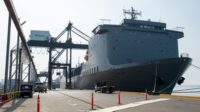Roughly 15 years after Anchorage planned to nearly double the footprint of the city’s Port of Alaska—one of the most important in the U.S.—the extended section where the expansion was to be remains unusable.
Sinkholes have opened and there are questions about its ability to withstand earthquakes. So the newest version of the billion-plus-dollar port modernization now excludes this problem-plagued area altogether.
A federal judge in Washington, D.C. on Feb. 24 ordered the federal government to pay Anchorage $367.4 million in a breach-of-contract lawsuit over the extension project. Port of Alaska Director Steve Ribuffo said in a statement that the money will enable the planned fixes to be made as officials continue seeking funds for the overall modernization.
About half of the state’s inbound freight passes through the Port of Alaska, and the US Defense Dept. counts it as one of 20 ports deemed economically and strategically significant. In a statement, Anchorage Mayor Dave Bronson called the port “the single most important piece of infrastructure in the state.”
Built in the 1960s, the port's expansion and renovation has been on the drawing board for decades.
In 2003, the Municipality of Anchorage signed an agreement with the U.S. Transportation Dept.’s Maritime Administration for the federal agency to handle design, construction and oversight of a project. Under the plan, the port was to extend northward, with new berths for shipping companies built on what had been tidal mudflats.
The agency contracted with engineering and construction management firm Integrated Concepts and Research Corp., which in turn subcontracted with another engineering firm that developed a plan. It included U-shaped sheet piling and backfill to add 135 acres. ICRC also hired a contractor for earthwork and sheet pile bulkhead work, and that company subcontracted out the sheet pile installation.
"It looks like land, smells like land, tastes like land, but it's not really land."
-Jim Jager, Port of Alaska
After construction began, the contractors experienced problems driving the sheet piles, which were damaged by excessive blow counts. Despite the complications and problems, MARAD did not have any personnel present at the worksite and took no action, Anchorage later alleged in a lawsuit.
The project mostly stopped after the 2010 construction season—work can only be done during summers because of Alaskan weather—and remained in limbo for the next few construction seasons. Then the extensive problems led local officials to stop further work.
A 2013 report prepared by engineering firm CH2M Hill for the US Army Corps of Engineers found that a dry barge berth had been successfully constructed, but there were defects with other parts of the project. Large rocks and stuff clay encountered during sheet piling installation damaged many sheets beyond repair. Sinkholes formed along part of the extension where sheet piles are out of interlock below the waterline, allowing saturated backfill to pass through openings. A wet barge berth and the two phases of north extensions do not meet standards for the area’s seismic activity.
Parts of the extension would not be sufficiently stable even if they could be repaired, the report concluded.
“So it looks like land, smells like land, tastes like land, but it’s not really land,” says Jim Jager, director of business continuity and external affairs for Port of Alaska. “It could fail at any point.”
Anchorage has settled claims against several of the companies involved in the project. But Jason Smith, an attorney who specializes in construction and represents Anchorage in its case against the federal agency, says the municipality was limited in what it could pursue from the contractors because it did not hold contracts with them.
Those settlements total about $20 million, while court records state Anchorage contributed about $302 million toward the project.
In 2014, Anchorage sued the Maritime Administration, alleging breach of contract. A judge ruled in favor of Anchorage last December before setting the award Feb. 24 at $367.4 million.
That aligns with what the municipality sought for money it had spent on the failed project and what it expects to spend removing the unusable extension.
“We had a contract with [the agency],” Smith says. “It was clear to us that it was responsible for the overall project management and the design and construction of the project. So we saw them, frankly, as the more culpable party.”
"It was clear to us that [the U.S. Maritime Administration] was responsible for the overall project management."
-Jason Smith, Seyfarth
MARAD has 60 days to appeal the ruling. A spokesperson for the agency declined to comment on the case, citing pending litigation.
The ruling comes as Anchorage is in the midst of a port modernization plan with a price tag estimated between $1.6 billion and $1.8 billion. Municipality officials say they still need $600 million from the state to design and construct a seismically resilient cargo dock.
It is necessary to remove the unstable work from the previous failed project for the modernization program to move forward, Jager says. There is a risk that the sheet piles walls could fail, allowing fill material to slide into the inlet and block the navigation channel.
The modernization program is designed to allow the port to accommodate larger cargo ships that have become standard since the current docks were built in the 1960s. It will also optimize the port’s efficiency, allowing it to handle a larger volume. The program is also intended to improve the port’s resilience in light of seismic activity, with port documents stating that the first new terminal is designed to withstand an earthquake even more severe than Alaska’s 1964 earthquake.
The port plans to replace the aging docks one at a time. The first piece of the program, a new petroleum and cement terminal, is expected to open sometime later this month or in early April. Jager says Jacobs Engineering is the project manager, and work on each dock will be bid out separately as self-contained projects, in part because of Alaska’s limited construction season.
Work planned for 2022 includes the first of two phases of north shoreline stabilization and replacement of an administration building. The modernization program is expected to last about 10 years, Jager says.
Impacts on Other Projects
With money now moving toward projects funded by the Infrastructure Investment and Jobs Act, Smith, the lawyer for Anchorage, says the case may impact how contracts between different public entities are structured. Government agencies need to think about how they want to manage their risk for those projects, and consider alternative ways to funnel money into them without taking on the risk that the Maritime Administration did with Port of Alaska, he says.
“I suspect we’re going to start seeing more use of cooperative agreements and direct grants to try to limit the federal government’s exposure on projects like this,” Smith says. “And then you’re going to see changes in how the federal government operates with regard to insurance and surety bonds. I also think you'll see some changes in promises made by the federal government on what’s to be delivered by third-party contracts.”
The Anchorage port case can also be a lesson for contractors looking to work on projects involving multiple government agencies.
Poorly-drafted exclusionary language in subcontracting agreements allowed Anchorage to pursue claims against some parties with whom it didn’t have a contract, Smith says. “There has to be protective language for design issues.”





Post a comment to this article
Report Abusive Comment